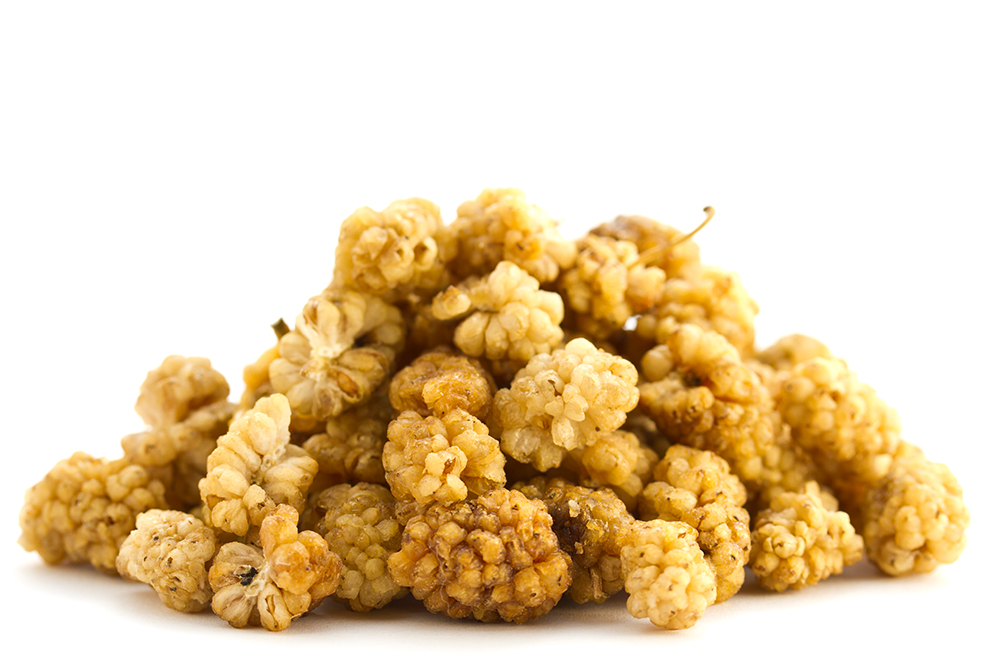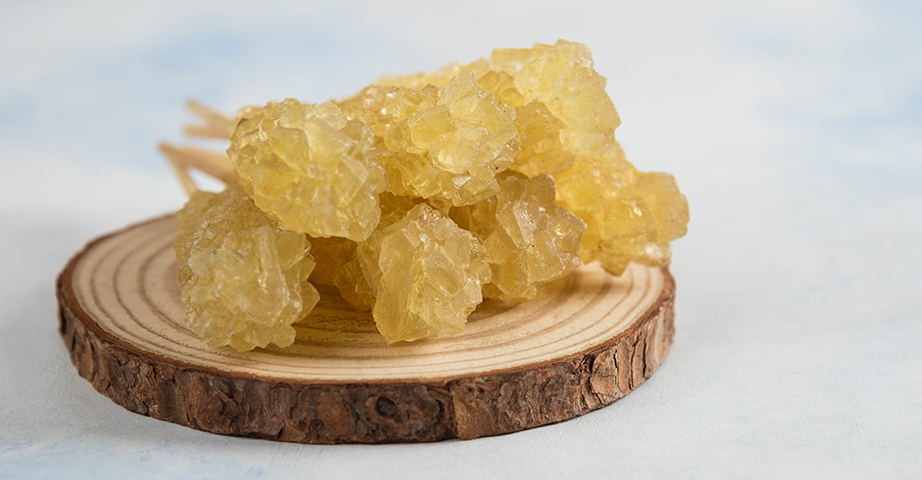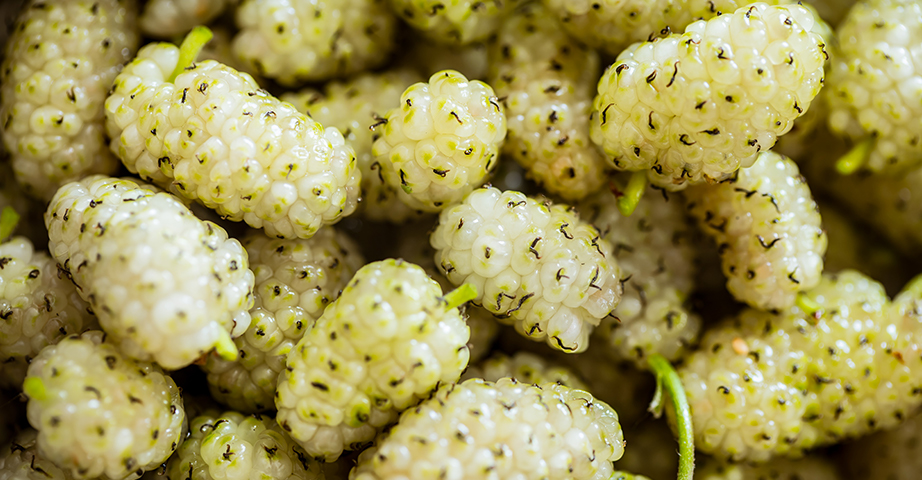White mulberry - a natural treatment for diabetes

White mulberry is a plant with a variety of different functions in traditional Chinese medicine. Tea made from its leaves is one of the oldest anti-diabetic preparations. Modern science confirms its helpful potential in diabetes as well as in other diseases. What does white mulberry help? How to drink mulberry tea for diabetes? How to choose good white mulberry tablets?
What is the white mulberry?
White mulberry (Morus alba) is a broad-leaved tree native to China, which also grows widely in India and Japan. It can reach a height of even 15 metres. White mulberry leaves are eaten by silkworms, so the tree is grown wherever silk is produced. White Mulberry can be found in the southern regions of the United States, Europe and Asia - in warm climates. In China, silkworms have been fed with its leaves for 4,500 years. However, it is not the reason for the plant's great popularity. Today, white mulberry is very common among healthy lifestyle enthusiasts.
White mulberry is a traditional raw material of Chinese medicine. Its fruit and leaves are crucial in phytotherapy. White mulberry fruits are similar in shape to raspberries and are not necessarily white. As the fruit ripens, it changes colour from creamy white to dark blue (like blackberries) and the name white mulberry comes from the white colour of its bark. In Poland, you can usually buy dried white fruit. White mulberry leaves have heart-shaped leaves with serrated edges. Dried ones are used to make tea. White mulberry is also an ingredient of dietary supplements. It is attributed to numerous preventive and health-promoting properties.
Recommended products with white mulberry
Function and traditional use of white mulberry
According to traditional Chinese medicine, white mulberry is used for treating upper respiratory tract infections, eye infections and parasitic diseases. An infusion made from its young leaves was given to breastfeeding women, as it was believed to strengthen the body and stimulate lactation. It also provided support for the liver. White mulberry tea was used to protect it from toxins, promote liver regeneration, bile flow, and its antioxidant properties. On the other hand, older people drank it to strengthen their joints and lower blood pressure. Fresh fruit was consumed for dizziness, vision problems, indigestion, high blood pressure and swelling. Finely ground dried fruit was a kind of nutrient that people took on exhausting journeys.
Today, it is known that white mulberry has the strongest health properties in preventing type 2 diabetes. Its anti-diabetic effect has been noted since ancient times, although at that moment the disease was not called diabetes. In the first book recording the methods used in Chinese herbal medicine dating around 500 AD, the author wrote: "If the juice (of the herb) is brewed and used as a substitute for tea, it can stop exhaustion and thirst." Untreated diabetes manifests itself with very strong thirst, Glycosuria and emaciation of the body. Consequently, a white mulberry leaf tea is one of the first products used in diabetes.
White mulberry is also very important in modern medicine in China. It is recommended by the Chinese pharmacopoeia with scientific studies confirming at least some of its traditional usages and clarifying white mulberry's action mechanisms.
White mulberry tea or dried white mulberry?
White mulberry leaf and dried mulberry (fruit) are different raw materials in phytotherapy with various chemical compositions and health-promoting potentials. The health-promoting properties of white mulberry leaves, which are used to prepare tea, are much better. Dried white mulberry, on the other hand, is used more as a supplement to a healthy, well-balanced diet.

Bioactive compounds in white mulberry leaves
The most important bioactive ingredient in white mulberry leaves that makes it recommended to drink is a 1-deoxynojirimycin (DNJ), which belongs to the class of polyhydroxy alkaloids. DNJ has proven activity in regulating carbohydrate metabolism along with showing health-promoting properties in preventing type 2 diabetes. White mulberry leaves also contain vitamin C (100-200 mg/100 g), beta-carotenes (8,44-13,13 mg/100 g), iron (19-50 mg/100 g), zinc (0,72-3,65 mg/100 g), calcium (786,66-2726,66 mg/100 g), phosphorus (970 mg/100 g) and magnesium (720 mg/100 g). ery valuable components of the leaves that pass into white mulberry tea are polyphenols. The most important of these are quercetin, rutin, kaempferol, astragalin and chlorogenic acid. The total polyphenol content ranges from 12.81 to 15.50 mg GAE (gallic acid equivalent) in 1 g of the dry weight of white mulberry leaves. Due to the presence of polyphenols, white mulberry tea displays antioxidant activity and may help prevent inflammatory diseases including atherosclerosis and cancer. Mulberry leaf tea also contains numerous substances with antimicrobial properties.
Bioactive compounds in dried white mulberry fruit
Dried white mulberry fruit belongs to the group of superfoods – very nutritionally rich food ingredients, providing antioxidants, vitamins and minerals in high concentrations. Dried white mulberry fruits contain 1,55 g protein per 100 g, 0,48 g fat, B group vitamins, vitamin C and minerals [per 100 g] – potassium [1,62-2,13 g], calcium [0,19-0,37 g], magnesium [0,12-0,19 g], sulphur [0,08-0,11 g], iron [28,2-46,74 mg], copper [4,22-6,38 mg], zinc [14,89-19,58 mg], manganese [12,33-19,38 mg]. The antioxidants in dried white mulberry are mainly anthocyanins.
As it is shown in the presented composition of bioactive compounds, white mulberry leaves are much richer in health-promoting components. The most important difference is the absence of DNJ in the fruit, as this alkaloid shows the greatest auxiliary potential of all-white mulberry components.
White mulberry tea - how to drink it?
White mulberry tea is made from dried mulberry leaves. Pour 200 ml of boiled water into 1 teaspoon of leaves (2 g) and brew for 5-7 minutes, covered, then strain.
You don't have to drink a lot of white mulberry tea to achieve its health benefits. According to scientific studies, an infusion of 1 g of dried mulberry leaves drunk 3 times a day is sufficient to achieve a hypoglycaemic ( lowering of glucose levels) effect. For other purposes, there is too little evidence to support the medicinal effects of mulberry tea.
White mulberry tablets
White mulberry tablets contain extracts of mulberry leaves. Good tablets should be standardised for the presence of DNJ per dose, rather than just claiming the extract content. The extract itself, depending on the origin of the leaves and the method of extraction, can provide different amounts of bioactive substances, as it is the specific amount of bioactive substances that are relevant to be able to talk about the health efficacy of a compound.
The price of white mulberry tablets varies, usually between 10 and 30 PLN for a pack of 30-60 pills. When buying a supplement with mulberry leaf extract, you need to consider not only the price but the content of the extract per tablet, as well as its standardisation. Tablets in which the extract is not standardised for DNJ content are usually cheaper (there are also expensive preparations without standardisation; then we pay for marketing). You can also find supplements in which there is hardly any white mulberry extract. Therefore, opinions on the effectiveness of white mulberry tablets can be extremely varied. Good capsules should contain at least 250 mg of white mulberry leaf extract standardised for DNJ content.
According to scientific opinions, white mulberry tablets are effective in regulating carbohydrate metabolism. Taking them can be a part of anti-diabetic therapy.

White Mulberry - anti-diabetic effects
The anti-diabetic effect is the best-proven property of white mulberry leaf extract. It has been confirmed by numerous scientific studies, first conducted on animals but in recent years also involving humans. DNJ has been proven to reduce the absorption of carbohydrates in the small intestine, which has a positive effect on glycaemia (lowering of sugar levels) and postprandial insulinaemia.
A randomised, double-blind, placebo-controlled trial involving 37 participants without diabetes analysed the glucose and insulin response to the administration of 50 g of maltodextrin. White mulberry extracts containing 6.25 mg, 12.5 mg or 25 mg DNJ were used. The extracts proved to reduce glucose levels after maltodextrin intake compared to placebo by 6.1%, 14% and 22%, respectively, and insulin levels by 9.7%, 23.8% and 24.7%.
17 subjects were given 1000 mg of white mulberry leaf extract 3 times a day for 3 months. Participants experienced an average decrease of 16.1% in postprandial blood glucose.
White mulberry - other properties
White mulberry also has other preventive properties. Many studies are in progress to confirm or exclude its health-promoting effects in metabolic and inflammatory diseases. The available scientific literature suggests that the benefits of using white mulberry include:
- extracts from white mulberry leaves can lower the level of total cholesterol and increase the level of 'good' HDL cholesterol in the blood.
- Taking mulberry leaf extracts has anti-inflammatory effects. It can lower levels of CRP and other inflammatory markers.
- White mulberry leaf extract may have a protective effect on liver cells.
- White mulberry leaf extracts may increase lipid oxidation - accelerating fat burning. However, this does not mean that white mulberry has a slimming effect. All compounds that increase the metabolic rate have a supporting effect on weight loss, not slimming.

